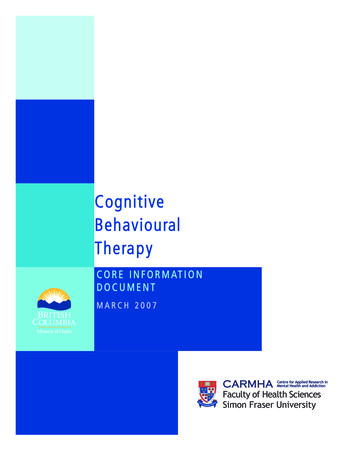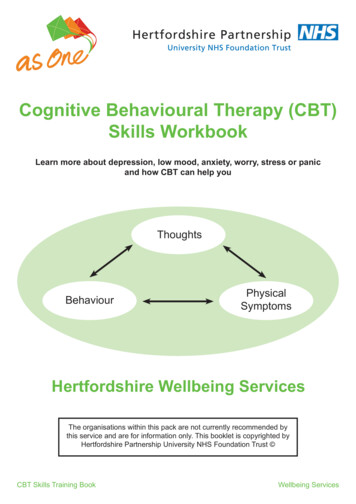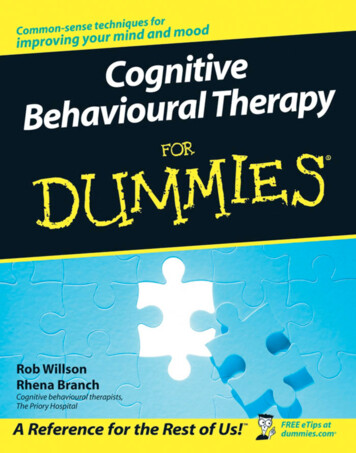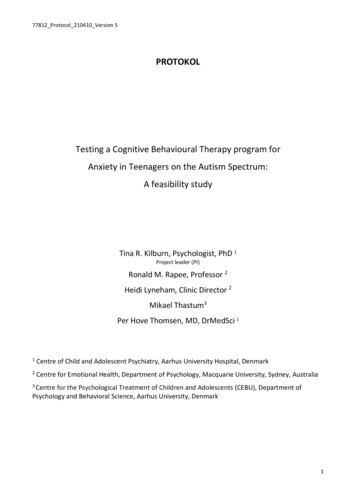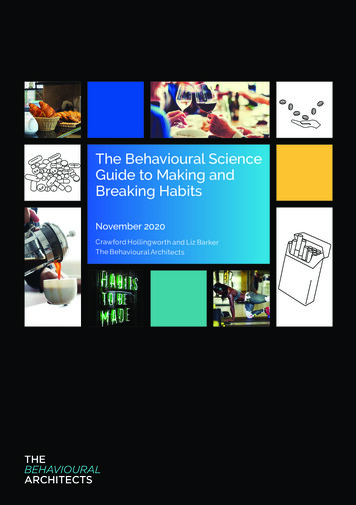
Transcription
11Making and Breaking Habits1111The Behavioural ScienceGuide to Making andBreaking HabitsNovember 2020Crawford Hollingworth and Liz BarkerThe Behavioural Architects1
2The Behavioural Architects
TABLE OF CONTENTSSECTION 1: Introduction to habits1.1 What is a habit?1.2 Habits – The holy grail of marketing1.3 Why do we need habits? Why do habits form? How habits free up our brain How habits help us in times of stress How habits help us as we grow old How habits, not self-control are the key to success1.4 Key features of habitsSECTION 2: Six strategies for building a new habit2.1 Six strategies for building habits2.2 Case studies of building new habitsSECTION 3: Why habits are hard to break3.1 Case studies of breaking bad habitsSECTION 4: Measuring habits4.1 Why measure habits?4.2 What measures can give us an idea about habitstrength?4.3 Simple tools to measure habit strength: The SelfReport Habit Index
4The Behavioural ArchitectsSECTION 1: Introduction to habits“To uproot an old habit is sometimes amore painful thing, and vastly moredifficult, than to wrench out a tooth.”Our habits make up a surprisinglysignificant proportion of our daily lives.In fact, the philosopher and psychologistWilliam James believed that they formeda huge proportion of our daily lives,writing “99%, or possibly 99.9% of ouractivity is purely automatic and habitual”.Whilst this is a little over the mark, it’sstill at least partially true – researchby Wendy Wood and colleagues foundthat between one third and nearly halfof students’ daily activity was habitual.Examining the diaries of students andcommunity members they concludedthat up to 45% of the activities and taskswe undertake in our day are habitual.1Once formed, they become such secondnature that breaking or changing themcan be near impossible. The 19th centuryScottish writer Samuel Smiles observedthat “To uproot an old habit is sometimesa more painful thing, and vastly moredifficult, than to wrench out a tooth.”2understand the importance of habitualbehaviour given they play such a hugerole in our lives. Not only are researchersdevoting time and energy to this field,but so too are practitioners – from techcompanies to healthcare workers - andthere is a growing interest among thepublic generated by popular, bestsellingbooks such as Wendy Wood’s ‘GoodHabit, Bad Habit’, BJ Fogg’s ‘Tiny Habits’and Charles Duhigg’s ‘The Power ofHabit’.In this book, we draw on this knowledgeto narrow down on a definition ofhabits; understand why habits are sohard to break; how we can best buildnew habits; why habits, not willpowerare usually the driving factor behindsuccessful people; and how we can mosteffectively measure habits to assess howstrong they are. These points are evenmore important today, as habits havebeen hugely disrupted by the Covid-19pandemic and remain in flux.In the last decade, after lying dormantfor a long while, the science of habits hasundergone something of a resurgence.Psychologists, neuroscientists, animallearning researchers and behaviouralscientists alike have all come toQuinn, J.M., & Wood, W. (2005). Habits across the lifespan. Unpublished manuscript, Duke University; Wood, W., Quinn, J.M., & Kashy, D. (2002). Habits ineveryday life: Thought, emotion, and action. Journal of Personality and Social Psychology, 83, 1281–1297.Samuel Smiles, ‘Character: The True Gentleman’, Self-Help (1856), Ch 131 2
Making and Breaking Habits1.1 WHAT IS A HABIT?Whilst we all have some sort ofunderstanding of what a habit is, it canbe useful to define it more narrowly.Behavioural scientists Bas Verplanken andHenrik Aarts define habits as “a learnedsequence of acts that have becomeautomatic, unconscious responses tospecific cues or triggers around us”3.More recently, others now define a habitas a process4 that generates a particularbehaviour:“a process whereby contexts promptaction automatically, throughactivation of mental context-actionassociations learned through priorperformances.”Our habits are deeply engrained in ourbrain and muscle memory so much sothat they become automatic. We candefine this autopilot behaviour by threequalities: Minimal awareness – we can carryout the action without needing to paymuch attention to what we are doing E fficiency – we can carry out a habitualbehaviour in parallel with otheractivities demanding more attention L ack of control and consciousintention – we do things without actualconscious intention or desire and it’sactually difficult to stop yourself fromdoing them or to do them differently5This means we can be quite unawarethat some of our actions are habitual.For example, we might make a cup of teaand add a couple of biscuits on the side(not realising that we add that coupleof biscuits every time we make a cupof tea), or we might unknowingly useparticular expressions so often that wedrive other people mad (if we were everto read a transcript of our conversationswe’d probably be horrified to hear thenumber of ‘you knows’ or ‘likes’ or‘super-this’, ‘super-that’ that punctuateour everyday lexicon), or each morningat work we might find ourselves ‘unableto function’ without a first cup of coffee.These are all habitual behaviours thathave become fixed in our neurologicalpatterning. Sometimes our habits areso embedded in our subconsciousthat they get us running on autopilot.When we’re driving a familiar route, forinstance, we might have no consciousrecollection of any details of the journey,or trolleying our pre-ordained circuitof the supermarket we probably won’tnotice anything about the other peoplewe pass and we’re totally thrown if thelayout of the store and product displayhas been altered.1.2 HABITS – THE HOLY GRAIL OFMARKETINGHabits are in effect, the marketing ‘holygrail’. Around half of new products fail6and it is habits that can explain why –and crucially how and why the few thatbecome embedded in our lives succeed.Verplanken, B., Aarts, H. Habit, Attitude, and Planned Behaviour: Is Habit an Empty Construct or an Interesting Case of Goal-directed Automaticity?European Review of Social Psychology, Volume 10, 1999 - Issue 1, Gardner, B. & Rebar, A. ‘Habit Formation and Behaviour Change.’ 2019, Oxford ResearchEncyclopaedia; Gardner, B. ‘A review and analysis of the use of “habit” in understanding, predicting and influencing health-related behaviour’, 2015, HealthPsychology Review, 9(3) 277-2954 Gardner, B. & Rebar, A. ‘Habit Formation and Behaviour Change.’ 2019, Oxford Research Encyclopaedia; Gardner, B. ‘A review and analysis of the use of“habit” in understanding, predicting and influencing health-related behaviour’, 2015, Health Psychology Review, 9(3) 277-2955Verplanken, B., Wood, W., ‘Interventions to break and create consumer habits’, 2006, Journal of Public Policy and Marketing, Vol. 25 (1), Spring, 90-1036Andrew, J., & Sirkin, H. (2003). Innovating for cash. Harvard Business Review, 81, 76–83. doi:10.1225/R0309E3 5
6The Behavioural ArchitectsWhen new behaviours – new productsor services – are not adopted, thereal problem often lies not in a lack ofawareness or knowledge on the part ofthe consumer, or even a lack of intentionto use, but in the failure to changeexisting habits or adopt new ones. Andthis is where insights from behaviouralscience – the rapidly growing scientificstudy of our behaviour and decisionmaking which acknowledges the inherentbiases and distortions that characterisehuman judgement and decision making– comes in. Behavioural scientists callthis phenomenon the ‘Intention-Actiongap’. For example, there is a provengulf between intending to exercisedaily and actually doing it. Most adultsknow exercise is good for them andwould like to do more, yet global studieshave shown that between 36% to 55%of people never manage to convertintention into action.7 Similarly, otherresearch has identified intention-actiongaps for handwashing before eating; a2013 study found that whilst the majorityof people know it’s important to do this,barely 20% actually did.8A study looking at why consumersfailed to adopt new products foundthat a quarter of the instances in whichconsumers failed to use a new product– in this case a new fabric refresher forclothing - were due to the interferenceof an existing habit.9 Failure to use thenew product was rarely due to dislikingit or finding it did not work properly;consumers simply forgot to use theproduct, and automatically reverted toexisting habits. Take a look through yourkitchen cupboard or your bathroomcabinet and you’re sure to find somerelics that you bought enthusiasticallybut forgot to ever use.“Marketers don’t always go out in thefield and see what people are doing andhow they would use a new product,” saysWendy Wood, professor of psychologyand business at the University ofSouthern California and co-author ofthe study above. “But this is actually acritical part of new product launch. Evenif consumers like a new product and wantto use it, they won’t do so if it conflictswith their habits.” She emphasises that“The broad implication of our work is notto fight against consumers’ past behavior,but instead to enlist it as an ally topromote the successful adoption of newproducts.”10Experienced marketers all know thatchanging behaviour once is not toodifficult but changing it for good ismuch harder. Behavioural scientists KatyMilkman & Angela Duckworth agree:“ the biggest problem that neededsolving was figuring out how to makebehaviour change stick.”11“Even if consumers like a newproduct and want to use it, theywon’t do so if it conflicts with theirhabits.” hodes, R.E., de Bruijn, G.J. How big is the physical activity intention–behaviour gap? A meta-analysis using the action control framework. Br J Health Psychol. 2013;18:R296–309; Godin G, Conner M. “Intention-behavior relationship based on epidemiologic indices: an application to physical activity”, American Journal of Health Promotion. 2008Jan-Feb; 22(3):180-2.8 Rabbi, SE, Dey, NC. Exploring the gap between hand washing knowledge and practices in Bangladesh: a cross-sectional comparative study. BMC Public Health. 2013 Jan30;13:89. doi: 10.1186/1471-2458-13-899 Labrecque, J.S., Wood, W., Neal, D., & Harrington, N., Habit slips: when consumers unintentionally resist new products, Journal of the Academy of Marketing Science, June 201610https://www.eurekalert.org/pub s/7
7Making and Breaking HabitsTherefore, it’s crucial for any marketer tobe able to have a reliable and effectivestrategy for building new habits andmaking them stick. First, we need todevelop a complete understanding ofthe habitual behaviour in focus, and thenanalyse how might it be built, maintainedand broken or changed.Fortunately, over the past few decades,valuable new insights from the rapidlygrowing field of behavioural science –including from psychology, neuroscience,and behaviour change – have given usthe concepts, frameworks and tools forus to not only better understand habitualbehaviours but also to inform and inspirethe development of a best practiceapproach to building or breaking habits.“Habit and routine free the mind formore constructive work.”1.3 WHY DO WE NEED HABITS?WHY DO HABITS FORM?“Habits form the bedrock ofeveryday life. Without habits,people would be doomed to plan,consciously guide, and monitorevery action, from making thatfirst cup of coffee in the morning tosequencing the finger movementsin a Chopin piano concerto.12Habits free up our minds:”Habits serve a significant purpose –certain behaviours become automaticmostly to make us more efficient. Wecan all recall being in a new, unfamiliarenvironment – perhaps working abroad,or visiting friends with a very differentlifestyle. It’s often disorientating andawkward, everything seems to takemuch longer because every singlechoice and behaviour requires consciousthought. This has been very noticeableduring the Covid-19 pandemic. AsWendy Wood notes: “The routines builtup over time are gone, so we all haveto make new decisions about how welive now. Everything we do requires adecision, takes more energy and feelsuncertain.”So we build habits out of a desire forefficiency – rather than make 100 decisions throughout our day, we singleout any choices which we can automateso that eventually, new habits developwhich make our lives much smootherand more fluid. These new habitsactually free up our minds so that we cando other things in parallel. As TheodoreRoosevelt said “Habit and routine free1213Neal, D., Wood, W., Quinn, J. ‘Habits – A repeat performance’ 2006, Current directions in Psychological Science, Vol 15, No. 4, p198James, W. “The Principles of Psychology”, vol. 1, 1890, New York; Henry Holt, p122
8The Behavioural Architects“With a habit, you are never leftwithout a response, even when stress,distraction or mental tiredness isderailing your conscious mind.”the mind for more constructive work.”Similarly, William James believed that“The more of the details of our dailylife we can hand over to the effortlesscustody of automaticism, the more ourhigher powers of mind will be set free fortheir own proper work.”13Habits can also be our friend in times ofstress:Research has found that when we areput under stress, we fall back on habitseven more than usual. Stress pushesour conscious reasoning and decisionmaking ability – our executive controlor ‘System 2’ to the back seat, lettingtried and tested unconscious habitscome to the fore. Evolutionarily, this wasto our advantage. As Professor WendyWood says “With a habit, you are neverleft without a response, even whenstress, distraction or mental tirednessis derailing your conscious mind.”14Whether the response is good or baddepends on how many good and howmany bad habits you have though. Ifyou’ve built good habits aligned to longterm goals, it’ll be plain sailing. Badhabits AND stress could leave you in amess though! Furthermore, if you areunder stress, you’ll probably find it hardto break old habits and adopt new ones.During the Covid-19 pandemic, lack ofroutine and disrupted habits have beenone factor behind increased stress andmental health issues. This creates aviscious circle as stress makes new habits14Wood, W. “Good Habits, Bad Habits” 2019harder to build.Habits also serve us well as we grow old:Whilst younger people tend to relymore on their analytical skills – knownas fluid intelligence – to make decisions,as people age they tend to draw moreon their knowledge and experience –known as crystallised intelligence - tomake decisions. Although older peopleare still capable of drawing on theirfluid intelligence for decision-making,it takes more effort as it’s harderfor them to ignore or sift throughirrelevant information. They thereforetend to be more selective aboutusing System 2, saving their cognitiveresources for important decisions withsignificant consequences and relyingmore on habits, rules of thumb andoft-used mental shortcuts – System 1decision-making – for less important,inconsequential decisions. For example,older people often stick to the productsand places that they know which requirelittle thought to purchase or to travel to.This helps them when they come acrossnew, unfamiliar situations where it’s notpossible to fall back on their experience,or a habit.How habits, not self-control are the keyto success:Many people assume that the key tobecoming successful (by that, let’sdefine it broadly as ‘things going in ourfavour’) is high levels of self-control. Thisstems from an historic Protestant workethic based mainly around hard work,but also of self-denial, fending off allimpulsive urges. We have an image of ahighly motivated person waking at the
Making and Breaking Habits“Our prototypical model of selfcontrol is angel on one side anddevil on the other, and they battleit out We tend to think of peoplewith strong willpower as peoplewho are able to fight this battleeffectively. Actually, the people whoare really good at self-control neverhave these battles in the first place.1.4 KEY FEATURES OF HABITSSo, if a habit is ‘a learned sequenceof acts that have become automatic,unconscious responses to specific cuesor triggers around us’16 there are somekey features of habits that warrantdiscussion.”first alarm buzz and hopping out of bed,itching to go out for a jog before dawnbefore heading off to a twelve hour workday.Kentaro Fujita, a psychologist at OhioState University says “Our prototypicalmodel of self-control is angel on one sideand devil on the other, and they battleit out We tend to think of people withstrong willpower as people who are ableto fight this battle effectively. Actually,the people who are really good at selfcontrol never have these battles in thefirst place.”15 F irstly, let’s draw on neuroscienceto look more closely at how habitsare an ‘automatic, unconsciousresponse’. The 18th century writerSamuel Johnson intuitively observedthat “The chains of habit are tooweak to be felt until they are toostrong to be broken”, realising thathabits are very much automaticbehaviours.The latest research finds that what‘successful’ people are actually goodat doing is not resisting temptation,but simply building good habits. Theyaren’t born with any more self-controlthan the rest of us. By building goodhabits, they go through their day largelyautomatically, from one habit to thenext, meaning they often don’t even faceany need to draw on self-control to willthemselves to do something.“15The chains of habit are too weak tobe felt until they are too strong tobe anken, B., Aarts, H. Habit, Attitude, and Planned Behaviour: Is Habit an Empty Construct or an Interesting Case of Goal-14 directed Automaticity?European Review of Social Psychology, Volume 10, 1999 - Issue 116 9
10The Behavioural ArchitectsResponsible for: new or infrequent behaviours,especially those performed in different ways orcontexts each time (e.g., indoor residual sprayingfor malaria, IUD insertion, or vasectomy)Goal Directed SystemMain brain system: Pre-frontalcortexFeatures of process: Guided by attitudes/goals/values Conscious, deliberative Knowledge of steps can be verbalised Features of the action can be changed quicklyaccording to rules Performance is relatively slow, via thought andattentionResponsible for: established/frequentbehaviours, especially those performed in thesame ways or settings each time (e.g., oralcontraceptives, bed net use)Habit SystemMain brain system: Basalganglia Features of process:Guided by “cues” or “triggers”Less conscious, more “automatic”Performance of steps is not conscious, harderto verbalise Features of the action cannot be alteredquickly – only via experience/repetition Performance is quick, using heuristics andpast behaviour as a guide Doesn’t require thought or attentionFig 1: Different brain systems control goal-directed actions and habits. These two systems influence behaviour independently of each other (Source: Neal 2015; Wood & Neal 2007)
Making and Breaking HabitsMove forward 250 years andneuroscientific research now supportsthat observation. Any new behaviourbegins with conscious deliberation andintention, drawing on what is known asour executive function or ‘System 2’ –the prefrontal cortex area of our brain.This is the brain area that does all ourhard thinking - helping us do complexcalculations, learn a foreign languageor navigate our way to a new place. Theprefrontal cortex sends input to thecaudate within the striatum – providinginput into the basal ganglia - which thenhelps to achieve a behaviour by bothinitiating the right movement(s) while atthe same time ensuring that any wrongor unhelpful movements are inhibited.Neuroscientists have found that thestriatum plays an important role whenwe are learning a new behaviour or task.The award-winning MIT neuroscientist,Professor Ann Graybiel and her colleagueScott Grafton describe it as “a sort oflearning machine dedicated to achievingsuccess in behaviour.”17However, as we learn and repeat thebehaviour over time, our brain rewiresitself. We engage the prefrontal cortexless and less and the message inputssent to the striatum fade. Eventually,we completely shortcut our executivefunction and instead rely on the putamen– another part of the striatum withinthe basal ganglia, a more primitive areaof the brain which means that we are nolonger conscious of the behaviour butperform it automatically without needingto think about starting it or continuing it.1718This process is illustrated in recentresearch. Human brain imaging as peoplepractice sequential finger movements- like playing the piano - has found thatthere is progressively reduced activityin the prefrontal areas as they practice.And further evidence shows that thosewho reduce activity in the prefrontalcortex sooner, seem to acquire that skillor embed a habit faster. Instead, the newhabit is enacted automatically via other,more primitive parts of the brain.We can now carry out the behaviourwithout needing to think about itconsciously, saving us considerablebrainpower. Of course, this is problematicfor bad habits because it means we havelittle conscious control anymore. Graybielsays “Even if you really don’t want to, it’shard to not do.”Once a habit loop is formed, it is alsofixed in our neurological patterningforever. Over time, these wiring shortcutsdon’t disappear, even if we drop thehabit over time. A recent study by LeeSmith and Ben Gardner, drawing onlongitudinal data from the 1970 BritishCohort Study, found that children aged10 who often participated in sportswere more likely to participate in sportor physical activity at aged 42. Habitsformed in childhood can continue intoadulthood, even if they are ‘dormant’ forperiods of time.18Similarly, some of our old habits mayreturn post-Covid-19, if the context issimilar enough, although some may havebeen displaced by new habits.Graybiel, A., and Grafton, S.T. The Striatum: Where Skills and Habits Meet” Cold Spring Harbour Perspectives in Biology 2015;7 Smith, L, Gardner, B, Aggio, D & Hamer, M 2015, ‘Association between participation in outdoor play and sport at 10 years old with physical activity in adulthood’Preventive Medicine 74 ( 2015 ) 31-3511
12The Behavioural Architects H abits need a cue: A second keyfeature is that habits are alwaystriggered by a cue, typically in acontext that is stable and consistent inour lives. The cue triggers our memoryof doing the same action or routinepreviously and helps to initiate it again.Take making a cup of coffee, a familiarhabit for many. We might be cued by aparticular time of day (waking up), anobject in our surrounding environment(a cafetiere) or being in theenvironment as a whole (the kitchen),a preceding behaviour (turning onthe kettle), or even a person or sound(an alarm clock). When such anenvironment is stable and consistent –when we are in the same place at thesame time of day - we are more likely tocarry out a particular behaviour, deeplyembedding a habit. R epetition: For a behaviour to becomea true habit, it needs to be performedfrequently and repeated many timesover. Exact figures for how long it takesto build a habit vary, depending onthe complexity of the behaviour, but astudy conducted by Philippa Lally andcolleagues at the Health BehaviourResearch Centre at UCL in 2009 foundthat it took anywhere between 18days (2.5 weeks) and 254 days (over8 months) to embed a new habit. Theaverage time was 66 days.19 And thisassumes it is performed regularly –daily, or at least a few times per week.For example, a 2015 study lookingat the time taken to embed exercisehabits found that it took 6 weeks ofgoing to the gym 4 times per weekbefore the new habit was embedded.20A 2017 study found it took between106 days and 154 days to fully embeda habit depending on what time of daythe routine was performed - morningwas better than evening.21 So whenstarting a new habit, what can we doto drive and ensure repetition? R ewards: We can be motivated torepeat a behaviour if we experience areward and then associate this rewardwith the behaviour. This element canoften help to fix a behaviour in place soit becomes a habit – to the extent thatwe might not even need the rewardonce the behaviour has becomeautomatic. We can be motivated bymany different types of rewards – fromintrinsic to extrinsic, conscious andsubconscious, physical to physiological,short-term or long-term, one-off or areward that is cumulative and builds upover time. We may build a habit withjust a single reward, or with a mix ofdifferent types of rewards.With these three key features in mind –a behaviour that is automatic, initiated Lally P, van Jaarsveld CHM, Potts HWW, Wardle J. How are habits formed: modelling habit formation in the real world. Euro J Soc Psychol. 2010;40:998–1009Kaushal, N., & Rhodes, R. E. (2015). Exercise habit formation in new gym members: a longitudinal study. Journal of behavioral medicine, 38(4), 652-663Fournier, M., d’Arripe-Longueville, F. Rovere, C. Easthoope, C.C.Schwabe, L, El Methni, J., Radel, R. Effects of circadian cortisol on the development of a health habit. HealthPsychology, 36 (11), 1059-10641920 21
Making and Breaking Habitsby a cue or trigger, often repeated andembedded via a reward – we can nowconstruct a simple model of habits. The‘Habit Loop’ illustrated below helps tokeep in mind the essential elementswhich are needed to set about building anew habit.With this definition, key features and theHabit Loop model outlined, we will nowoutline some evidence-based strategiesand techniques which can be used tobuild and embed a habit into people’sroutines.RewardTriggerRoutineFigure 2: The Habit Loop, illustrating how the trigger initiates the routinewhich is followed by the reward. Source: The Behavioural Architects,based on a model by Charles Duhigg, ‘The Power of Habit’, RandomHouse, 2012.13
14The Behavioural ArchitectsSECTION 2: Six strategies to build a newhabit:How can we steer people to builda new habit that is sustainedover time? We’ve looked at severaldifferent models and frameworks frompractitioners such as Nir Eyal, B.J. Foggand Charles Duhigg to academics suchas Bas Verplanken, Wendy Wood andBen Gardner. All of these aim to aidunderstanding and/or build habitualbehaviours. For us though, the bestpractice approach comes from DavidNeal, a psychologist at Duke University’sCenter for Advanced Hindsight, whooutlines six strategies, each grounded inevidence from the behavioural sciences,which are effective for forming a newhabit.2.1 SIX STRATEGIES FORBUILDING HABITS:Each of the six strategies are tiered interms of their importance [with a colourkey]. Precondition - these strategies arean important foundation for buildingany new habit Acceleration - these strategies canhelp people adopt a new habitfaster Maintenance - these strategies canhelp a new habit stickPRECONDITIONACCELERATIONMAINTENANCE1. Ensure astable, supportiveenvironment3. Make it easy5. Practice andrepeat2. Leverage thecontext4. Develop cuesand rewards226. Build meaningand motivationLally, P. & Gardner, B. ‘Promoting habit formation’ Health Psychology Review 7(Supp 1) S137-SFigure 3: Six Strategies forBuilding Habits. Source:The Behavioural Architects2017 based on Neal, D. “TheScience of Habit”, 2015.
Making and Breaking HabitsStrategy 1: Ensure a stable, supportiveenvironment (Precondition)As we discussed above, a supportiveenvironment enables the creation ofconsistent cues which will begin toautomatically initiate a new habit. Thiselement is an important precondition – ifthe context or surrounding environmentis not set up for the desired habit,even the most determined, obstinatecharacters are going to struggle to start anew habit, let alone embed it! Researchshows habits are best promoted bycombining the first strategy with others a multi-pronged strategy.22Take the example of an avid musicfan, who listens to music via his longaccumulated CDs and records. Anonline streaming service would lovehim to develop a new listening habitvia streaming, but unless he has thesupportive technology (a good qualitytablet or laptop) with a fast, unlimited,reliable Wi-Fi connection, he is unlikely tomake the switch.Or there might be the health consciouswho would like to cut down on drinkingon a weekday evening. Success mightcome from making sure there is noalcohol in the home and finding adifferent drink – such as sparkling mineralwater – to substitute. Making these smallbut effective changes to the context canhelp promote a new habit.Another example is the would-be gymgoer, but whose life is unpredictable,involving frequent travel. This meansmany changes of context and irregularleisure time, if any. Studies of exerciseand healthy lifestyle habits have shownthat having a regular and stable placeto exercise – a regular class or clubor a tried and tested running routewill bed down any new sporting orphysical activity the best. For some,the Covid-19 pandemic has actuallycreated a much more stable homecontext for doing exercise due to beingat home more.Another illustration of this strategymight be the child encouraged by theirschoolteacher to read more. Here,having suitable books available at schooland in the home, as well as having anallotted time to read – perhaps beforebedtime – would help to build the habit.Strategy 2: Leverage the context(Precondition)This strategy is all about making thebest use of natural opportunitiesalready existing, or soon to exist, ina consumer’s environment or life meaning we marketers don’t need to doso much of the heavy lifting! This means15
16The Behavioural Architectsanalysing the specific context – are thereopportunities to develop new habits if a)old ones are temporarily disrupted by achange or b) by piggybacking to existinghabits?“It’s about intervening at the righttime. If you contact people withinthree months of them moving int
How habits help us as we grow old How habits, not self-control are the key to success Key features of habits SECTION 2: Six strategies for building a new habit Six strategies for building habits Case studies of building new habits SECTION 3: Why habits are hard to break Case studies of breaking bad habits SECTION 4: Measuring habits

